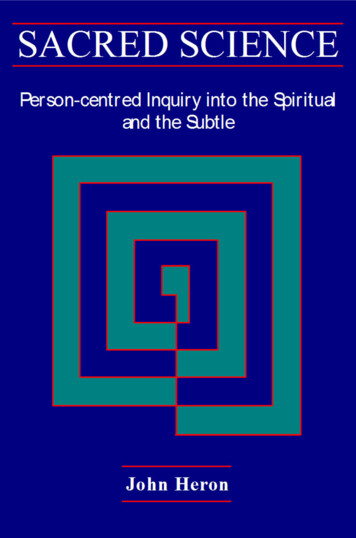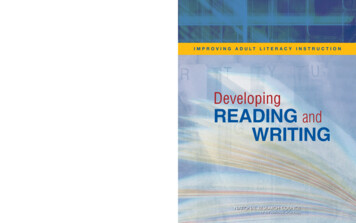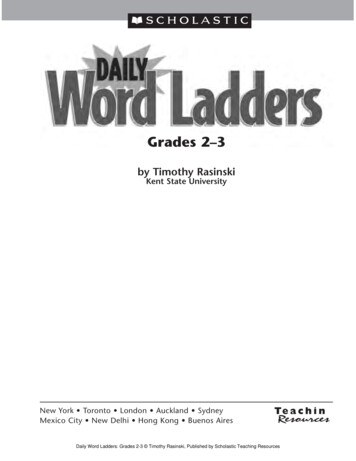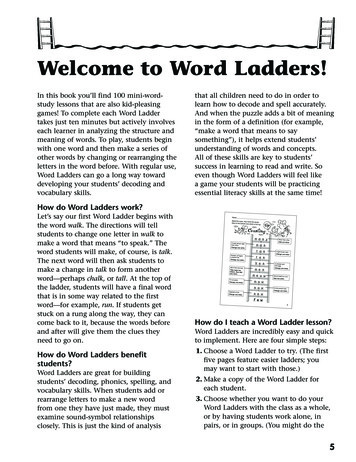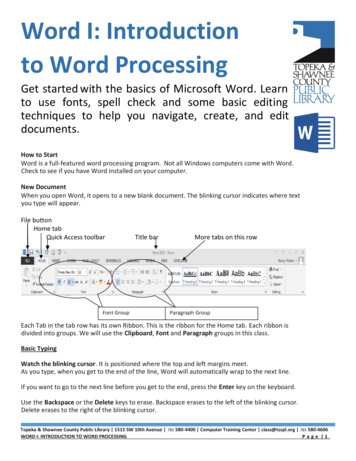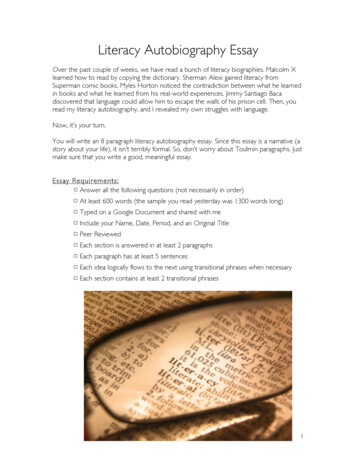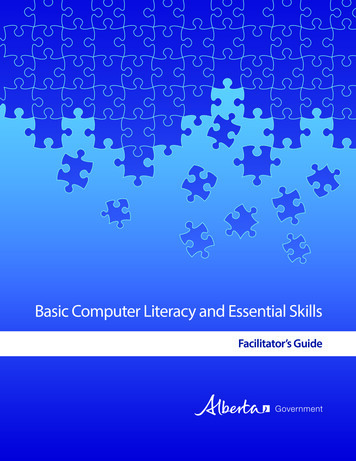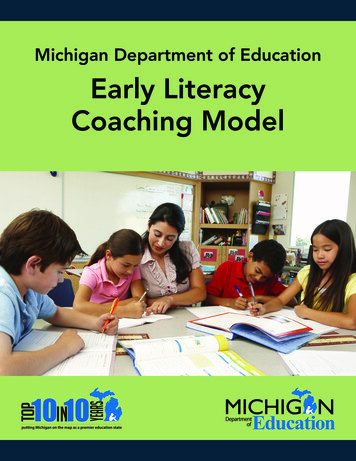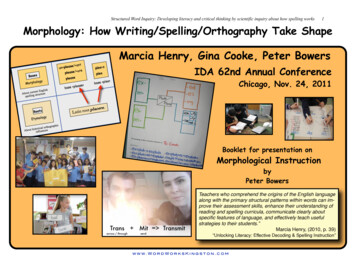
Transcription
Structured Word Inquiry: Developing literacy and critical thinking by scientific inquiry about how spelling works1Morphology: How Writing/Spelling/Orthography Take ShapeMarcia Henry, Gina Cooke, Peter BowersIDA 62nd Annual ConferenceChicago, Nov. 24, 2011Booklet for presentation onMorphological InstructionbyPeter BowersTeachers who comprehend the origins of the English languagealong with the primary structural patterns within words can improve their assessment skills, enhance their understanding ofreading and spelling curricula, communicate clearly aboutspecific features of language, and effectively teach usefulstrategies to their students.”Marcia Henry, (2010, p. 39)“Unlocking Literacy: Effective Decoding & Spelling Instruction”www.WordWorksKingston.com
Structured Word Inquiry: Developing literacy and critical thinking by scientific inquiry about how spelling works2What is crazy -- the English spelling system, or our typical systems for teaching spelling?Consider this story from a Grade 4 teacher about the struggle with yetanother word with “irregular” spelling.“Know More Explosions”Excerpt from a Grade 4 teacher’s emailMy program is for junior students identified with behaviourproblems, problems which make their full-time participationin "standard" classrooms problematic for everyone involved.Most of our students have ADHD identifications, often coincident with LDs and other difficulties, and virtually all ofthem read more than two grade levels lower than theyshould. In many instances, the students' behaviour difficulties and their language deficits pose a chicken-and-eggquestion.In a guided reading session I was doing with a burly andeager Grade 4 student reading at PM 9, the studentpointed to the work "know" and asked what it said. Knowing my students, I prepared him for my answer with "OK,this is going to blow your mind, but . . . ." When I finishedwith "It says /no/," he didn't miss a beat. He tore thebook off the table and flung it across the room. And thenhe started: "It does not f*#!ing say 'no!' " - giving thewhole class a language lesson as he tore a path toward theclassroom door - " k says /k/ and w says /w/, so itdoes not say f*#!ing 'no' !" How am I supposed to learnthis sh*!t when the rules change? K f*#!ing says /k/!"After the student de-escalated - and being told that knight says /night/ DIDN'T help, I promised him I'd findout why that word is pronounced as it is.RobbCursing our crazy spelling system is a likely response toRobbʼs story about the struggle to learn and teach reading and spelling in English. It would be so much easier ifwe just had a reliable, logical spelling system!Ironically, it turns out that our spelling system does meetthe exact criteria weʼve been asking for. Unfortunately theinstruction most of us have received makes it hard toeven imagine that this could be possible.It is important to recognize that the common assumptionof English spelling as an unreliable, exception-riddledsystem is a hypothesis that can be tested.The science of spelling: The evidence gathered fromscientific inquiry about the conventions of English spellingreveals plenty of evidence that English spelling is a highlyordered, coherent system (e.g. Carol Chomsky, 1970).Although there is obviously much more to spelling thanmorphology, the scientific study of English spelling makesit clear that we cannot make sense of our spelling systemwithout an understanding English morphology.Orthographic morphology is the conventional system bywhich spoken morphemes are written. Instruction can direct learners attention to this concrete representation ofthe meaning structure of words. Students can use thatknowledge to make define untaught words that are morphologically related to taught words (Bowers & Kirby,2010). But teaching morphology is not just about usingbases and affixes to learn new vocabulary. We cannotfully understand letter-sound correspondences withoutunderstanding the role of morphology, and research haslong established the importance of letter-sound knowledge for literacy development (e.g., Rayner et al., 2001).Click here for lessons investigating the spelling of know inspired by Robbʼs story.www.WordWorksKingston.com
Structured Word Inquiry: Developing literacy and critical thinking by scientific inquiry about how spelling worksIt makes sense that learning letter-sound correspondenceswould be facilitated by a fuller understanding of how theyoperate. To understand how our integrated morphophonemiclanguage works, one needs to know about the key components of that system and how they interact. As linguist Richard Venezky pointed out long ago, "the simple fact is that thepresent orthography system is not merely a letter-to-soundsystem riddled with imperfections, but, instead, a more complex and more regular relationship wherein phoneme andmorpheme share leading roles" (Venezky, 1967, p. 77).Consider: All of the words below have spellings that conform perfectly with the principles and conventions of Englishspelling Linguists have described.How many of these spellings can well trained teachers explain to children?criesskyreallyballhelpfulfullsee, seaheto, too, twotheir, thereridiculousreceivefriendshousegivepackageknew, new, knownightlaughed, painted,used, sled,been, teendoesbusinessbrother, hothouseputtingstopper, properprintsbankruptcyskiingquestionTeachers need to know about more than morphology to explainthese spellings, but it turns out that establishing whether agiven word is a base or if it is a base combined with other morphemes is a crucial first step in understanding a spelling.3What is the evidence that does is an irregular spelling?Typically instruction leads children to believe that does is one of many irregular spellings to memorize. In contrast,the word goes is treated as regular.Compare the interrelation of structure and meaning of the do and go word families illustrated with the matrix andword sums below.Notice how understanding the morphological structure of does and its relatives doing , does and done canbe used to introduce children to the fact that does is aningenious spelling because it marks its connection with theconsistent spelling of the base do .We can also use this spelling to show children that it isuseful that letters (graphemes) can represent more thanone pronunciation. Only in this way could the spelling of do and does use the same spelling of the base!When teachers understand morphology, they can use thespelling of the word does to introduce children to the ordered way their spelling system works!A morphological matrix for do and go dogoingesneWord Sums for do and go do ing doingdo es doesdo ne doneSee the explanation of the spelling of does and relatedwords that follows.www.WordWorksKingston.comgo ing goinggo es goesgo ne gone
Structured Word Inquiry: Developing literacy and critical thinking by scientific inquiry about how spelling worksGuides for Structured Word Inquiry“Big Ideas” to guide Structured Word InquiryOnce teachers develop a basic understanding of English spellingand they begin to take on the structured inquiry approach(Bowers & Kirby, 2010), they should be able to identify howany instruction of the written word reinforces one, two or orall of the following “big ideas.”1. English spelling is a highly ordered system for representingmeaning that can be investigated and understood throughscientific inquiry.2. Scientific inquiry seeks the most elegant solution -- thedeepest structure that accounts for the greatest numberof cases. (See this example)3. Analysis of word structure for meaning cues can be used todeepen understanding of concepts and terms in any subjectarea (Science example, Humanities example & video).Above figure from www.realspelling.comProcess of “Structured Word Inquiry”1) Catch learners with an interesting spelling question.(e.g., why g in sign ?)2) Strategically present a set of words that makes the relevantpattern more salient.3) Help learners hypothesize a solution from carefully presented evidence.4) Guide testing of learnersʼ hypotheses and identify the precise pattern.5) Practice the identified pattern with appropriate tools (e.g.,word sums, flow charts).See more on structured word inquiry, and the difference between“teacher-led inquiry” and “inquiry-led teaching” at this link.www.WordWorksKingston.com4
Structured Word Inquiry: Developing literacy and critical thinking by scientific inquiry about how spelling worksInterrelation of graphemesand morphemesThe word matrix(www.realspelling.com)uninreconquestLatin Rootquaerere‘ask, seek,gain’The matrix - a map of the interrelation ofstructure and meaning of written word familiessingedionsableingThe word matrix marks the only featureof an orthographic morphological familythat is static - the underlying orthographic representations of its morphemes, what Carol Chomsky (1970)called “lexical spellings.”base spelledmatrixquest ion question/kwɛst/in quest inquestingesnebase spelled do Graphemes are 1- 2- or 3-letter teams thatrepresent a phoneme. They occur withinmorphemes.Possible phonological representations of agrapheme are signaled by circumstances.The diagram above shows three of thepossible phonological representations ofthe t grapheme. Two of these are realized in the words of the quest matrixshown on this page.Note that since the o and the e graphemes in does are not in the samemorpheme, does cannot use an oe digraph.Word Sums (examples listed by pronunciation of base)/kwɛstʃ/ quest doThe word matrix represents members of an orthographicmorphological word family. Such word families share a connection in both structure and meaning. (See tutorial film &resource from Real Spelling here.) structure: common underlying spelling of the base meaning: common ultimate etymological origin of the baseInclusion of a word in a matrix is tested with a word sum.The word sum isolates the constituent morphemes (basesand affixes) on one side of the rewrite arrow (marking allmorphological suffixing conventions) and on the other, therealized surface structure of the word.An “echo” of the denotation of the root meaning of the baseof any word represented by a matrix can be detected in theconnotation of that realized word. The denotation of the rootmeaning of a word is checked with an etymological reference (e.g. etymonline.com).base pronounced5base pronouncedquest ion able questionablecon quest conquestWord Sums (examples listed by pronunciation of base)do ing doing/du://dʌ/re quest ed requesteddo es doeswww.WordWorksKingston.comdo ne done
Structured Word Inquiry: Developing literacy and critical thinking by scientific inquiry about how spelling works6A Series of “Teacher-Led Inquiry” lessons sparked from the question “Why is there a g in sign ?Taken from “Teaching How the Written Word Works” (Bowers, 2009)WordWorks Lessons! by Peter Bowers, 2007,www.wordworkskingston.comBased on (Ramsden 2001) www.reaslspelling.comNameWordWorks Lessons! by Peter Bowers, 2007,www.wordworkskingston.comActivity Sheet #1Word Building: Using a Real Spelling Word MatrixLesson #2: Spelling DetectivesWhen does Suffixing Cause Changes at the Joins?A WORD MATRIX USUALLY ONLY SHOWS SOME POSSIBLE WORDS, YOU CANUSUALLY FIND MORE IF YOU TRY!Rules for reading a word matrix: Read a matrix from left to rightalre Make only single, complete words from a matrixing If you are unsure that a word you build is a realedword, check a dictionaryasment You don’t have to take an element from everyifycolumn of a matrix – BUT You must not ‘leapfrog’ over a columnre deate ure WATCH THE JOINS – sometimes changes happenwhere you add a suffixA) Investigation: Developing a hypothesisStudy the matrix for move and the word sums created from it tosee if you can discover a consistent suffixing pattern.signWord Sums from move Matrix(Draw a line through silent e s replaced during suffixing as shown in the second sum.)Build words with your cut out prefixes and suffixes on the base sign . Once you have built aword, write the word sum as modeled in 1 and 2.reunPart A:prefix(es)-movebase - suffix(es)1) sign al! signal2) as sign ment! assignmentBased on (Ramsden 2001) www.realspelling.comsingedermentmove smove ingmove edmove ermove mentre move edre move erun move verunmoved1. What is the change that sometimes occurs at the suffix join?3) !2. List the suffixes that cause the change:3. List the suffixes that cause no change:4. How are these suffixes different from each other?4) !5) !6) !5. Our class’ hypothesis to explain how you know which suffixes mayforce a change at the join:7) !8) !9) !Real Spelling Tool Box Connections1K - Learning from Love (Learn about the letter v )3A - Revisiting Suffixing (Learn many roles of the single, silent e 10) !Real Spelling Tool Box Connection3E - The base elements sci and sign 4www.WordWorksKingston.com12
Structured Word Inquiry: Developing literacy and critical thinking by scientific inquiry about how spelling workswww.WordWorksKingston.com7
Videos of teachers and students spelling out word structure with word sums and working with matrices A Skype tutoring session with a Grade 2 student with word sums and the matrix. Go to the WordWorks YouTube page for many videos of students and teachers spelling out word sums and workingwith matrices.Structured Word Inquiry: Developing literacy and critical thinking by scientific inquiry about how spelling works8The Orthographic Word SumThe word sum is the basic linguistic tool for revealing the underlying structure ofany word. Complete these word sums, by writing and spelling them out loud. Makesure to show any changes. Note that in the “Analytic Word Sums” the user sometimes has to identify if the starter word is a base, or if it is complex. See a videomodelling the instruction of word sums at this link.Synthetic Word SumsSubstructure! # # #spring#care ful ly #spell ingSurface Structurespring #cute er# cut er# act ive ity es # marry ing# ##marry es# ##sky dive ing# ##carry age es # un heal th y ly # nate ure al ly # Analytic Word SumsSurface Structure! !alone# does# disease# spilling # duckling# rightfully# bookkeeper# assistance# sisterhood# disruptive#www.WordWorksKingston.com !Substructure
Structured Word Inquiry: Developing literacy and critical thinking by scientific inquiry about how spelling worksFrom the Matrix to the Word SumA foundational part of structured word inquiry is testing connections ofstructure and meaning by learning to building word sums from matrices.All of these matrices are taken from the Real Spelling 70 matrices DVD.That resource allows you to copy and paste any of those matrices tobuild lessons in minutes. With a little practice, teachers and studentssoon start building their own matrices.9Rules for reading a word matrix: Read a matrix from left to right.Make only single, complete words from a matrix.Only build words you can use in a sentence.You don’t have to take an element from every column of a matrix – BUT.You must not ‘leapfrog’ over a column.WATCH THE JOINS! Sometimes changes happen where you add a suffix.(See the Real Spelling “Big Suffix Checker” Or Neil Ramsden’s “Interactive Suffix Checker.”)Some ChallengesWrite your word sums that come from these matrices on a separate page.Investigate the matrices to build word sums that. Produce compound words. Show each of the suffixing changes. Force a change in the pronunciation of the base. Produce complex words that have ʻlong vowel soundsʼ.Some Questions Can you find a base with a digraph thatcan represent more then one phoneme? What base uses a trigraph? What base uses a t to represent /t/ inone derivation, but /ʃ/ in another derivation (the same phoneme commonly associated with the sh digraph). What questions challenges could you giveyour class from these matrices?www.WordWorksKingston.com
Structured Word Inquiry: Developing literacy and critical thinking by scientific inquiry about how spelling worksInvestigate word meanings by investigating theirspelling structure and historyFollow the traces of meaning marked by the “footprints” of spelling structure of the family of words built on the base vestige .10Learn about words from and with studentsThis matrix was constructed by a 12-year-old student named Thelonious and histutor right here in San Francisco. It was produced as the result of an investigation of the word investigate with the help of a new tool called the Word Microscope. This image was from their post on Real Spellers. It was by reading thatpost that I first learned of the spelling-meaning link between investigate and vestige .With the help of the matrix and word sums, elementary students can discoverconnections of meaning between words that few adults have made. This is justone piece of evidence that it is time to bring these reliable linguistic tools intoEnglish speaking classrooms everywhere.Go here for the word sums Thelonious and his tutor created, and the discussionthat grew on www.realspellers.org from this investigation. Download the WordMicroscope here. (For now it only available on PCʼs).Follow in the footsteps of Thelonious.Construct word sums from this matrix.The grapheme-phoneme diagram to the rightclarifies the sift in pronunciations associatedwith the g grapheme in these words.From the Oxford English Dictionary: vestige :ORIGIN early 16th cent.: from Latin investigat- ‘traced out,’ from theverb investigare, from in- ‘into’ vestigare ‘track, trace out.’ investigate :ORIGIN early 16th cent.: from Latin investigat- ‘traced out,’ fromthe verb investigare, from in- ‘into’ vestigare ‘track, trace out.’www.WordWorksKingston.com
Structured Word Inquiry: Developing literacy and critical thinking by scientific inquiry about how spelling worksLinks & ResourcesExplore the links to websites and resources listed here. To access thelinks throughout the document, email Pete at this address: peterbowers1@mac.com . I will be happy to send you the pdf that contains the hot-linked text.Wordworks: www.wordworkskingston.comFree resources, images, video clips and descriptions of this instruction inaction around the world. Vides of structured word inquiry in practice:www.you.tube.com/user/WordWorksKingston WordWorks Newsletter: Email us at wordworkskingston@gmail.comto receive our free Newsletter with updates, Word Detective Episodesand frequent extra resources. Teaching How the Written Word Works (Bowers, 2009). This bookbuilds on the 20 session intervention study I conducted (Bowers &Kirby, 2010) in Grade 4 and 5 classes. The lessons with the sign and move matrices are the first lessons in that book. Emailwordworkskingston@gmail.com to order a copy.The Real Spelling Tool Box 2 www.realspelling.comThis is not a spelling program or teaching approach. It a reference thatexplains how English spelling works. The linguistic rigour and clarity inthis reference allows learners to become word scientists.The 70 Matrix Disk: (follow links at www.realspelling.com)An excellent starting point for teachers.The Word Searcher: http://www.neilramsden.co.uk/spelling/A key free tool for collecting words according to surface patterns so thatword scientists can investigate the substructure of words. This is an invaluable tool for your spelling investigations. The above link includes alink to a free eBook to see how you might use it in the classroom.Real Spellers: www.realspellers.orgThis new website by Matt Berman (Grade 4 teacher at Nueva School!) isan excellent site for resources and spelling discussions from teachersaround the world.LEX rexchange.wordpress.com/An excellent blog by Gina Cooke for educators who trying to make senseof the linguistic structure of words.LEX Grapheme CardsA reliable reference of grapheme-phoneme cards from Gina Cooke.Email ginacooke@sbcglobal.net to order.11The Word /index.htmlThis software allows the user to construct matrices from word sums,search for likely members of morphological families and much more. Itguides learners in their quest to make sense of English spelling.Research NotesTo understand English spelling, we need to understand the interrelatednature of morphology, etymology and phonology. Morphology has beenignored or sidelined in typical classroom instruction (Nunes & Bryant,2006). Meta-analyses show morphological instruction brings benefits ingeneral, and in particular for less able readers (Bowers, Kirby, & Deacon,2010; Carlisle, 2010; Goodwin & Ahn, 2010). Bowers, Kirby, and Deacon(2010) also found that morphological instruction was as effective or morein Preschool to Grade 2 as it was in Grades 3-8. The matrix and wordsum provide tools teachers need to make sense of English spelling withtheir students.ReferencesBowers, P.N., Kirby, J.R. (2010). The effects of morphological instructionon literacy skills: A systematic review of the literature. Review of Educational Research, 80, 144-179.Bowers, P.N., Kirby, J.R., Deacon, S.H., (2010). Effects of morphologicalinstruction on vocabulary acquisition. Reading and Writing: An Interdisciplinary Journal, 23, 515–537.Carlisle, J.F., (2010). Effects of Instruction in Morphological Awarenesson Literacy Achievement: An Integrative Review. Reading ResearchQuarterly, 45, 464–487.Chomsky, C. (1970). Reading, writing, and phonology. Harvard Educational Review, 40, 287–309.Goodwin, A.P., & Ahn, S. (2010). A meta-analysis of morphological interventions: effects on literacy achievement of children with literacy difficulties. Annals of Dyslexia, 60,183–208.Henry, M. K. (2010). Unlocking literacy: Effective decoding & spellinginstruction. Baltimore: Brookes.Nunes, T., & Bryant, P. (2006). Improving literacy by teaching morphemes. New York: Routlege.Templeton, S. (2004). The vocabulary-spelling connection: Orthographicdevelopment and morphological knowledge at the intermediategrades and beyond. In J. F. Baumann & E. J. Kameʼenui (Eds.), Vocabulary instruction: Research to practice (pp. 118–138). New York:Guilford.www.WordWorksKingston.com
The science of spelling: The evidence gathered from scientific inquiry about the conventions of English spelling reveals plenty of evidence that English spelling is a highly ordered, coherent system (e.g. Carol Chomsky, 1970). Although there is obviously much more to spelling than morphology, the scientific study of English spelling makes
